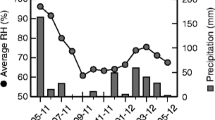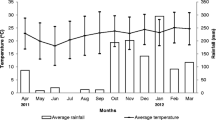Abstract
Highly eusocial bees (honey bees and stingless bees) sustain their colonies through periods of resource scarcity by food stored within the nest. The protein supply necessary for successful brood production is ensured through adjustments of the colonies’ pollen foraging according to the availability of this resource in the environment. In honey bees Apis mellifera, in addition, pollen foraging is regulated through the broods’ demand for this resource. Here, we investigated the influence of the colony’s pollen store level on pollen foraging and brood production in stingless bees (Melipona subnitida). When pollen was added to the nests, colonies increased their brood production and reduced their pollen foraging within 24 h. On the other hand, when pollen reserves were removed, colonies significantly reduced their brood production. In strong contrast to A. mellifera; however, M. subnitida did not significantly increase its pollen foraging activity under poor pollen store conditions. This difference concerning the regulation of pollen foraging may be due to differences regarding the mechanism of brood provisioning. Honey bees progressively feed young larvae and, consequently, require a constant pollen supply. Stingless bees, by contrast, mass-provision their brood cells and temporary absence of pollen storage will not immediately result in substantial brood loss.



Similar content being viewed by others
References
Alvares CA, Stape JL, Sentelhas PC, De Moraes G, Leonardo J, Sparovek G (2013) Köppen’s climate classification map for Brazil. Meteorol Z 22:711–728
Biesmeijer JC, de Vries H (2001) Exploration and exploitation of food sources by social insect colonies: a revision of the scout-recruit concept. Behav Ecol Sociobiol 49:89–99
Biesmeijer JC, Born M, Lukács S, Sommeijer MJ (1999) The response of the stingless bee Melipona beecheii to experimental pollen stress worker loss and different levels of information input. J Apic Res 38:33–41
Borges FVB, Blochtein B (2006) Variação sazonal das condições internas de colônias de Melipona marginata obscurior Moure, no Rio Grande do Sul, Brasil. Rev Bras Zool 23:711–715
Bruening H (2006) Abelha jandaíra, 3rd edn. SEBRAE, Mossoró
Camazine S (1993) The regulation of pollen foraging by honey bees: how foragers assess the colony’s need for pollen. Behav Ecol Sociobiol 32:265–272
Dreller C, Page RE, Fondrk MK (1999) Regulation of pollen foraging in honeybee colonies: effects of young brood, stored pollen, and empty space. Behav Ecol Sociobiol 45:227–233
Eckert CD, Winston ML, Ydenberg RC (1994) The relationship between population size, amount of brood, and individual foraging behavior in the honey bee, Apis mellifera L. Oecologia 97:248–255
Eltz T, Brühl CA, Van Der Kaars S, Chey VK, Linsenmair KE (2001) Pollen foraging and resource partitioning of stingless bees in relation to flowering dynamics in a southeast Asian tropical rainforest. Insect Soc 48:273–279
Ferreira Junior NT, Blochtein B, Moraes JF (2010) Seasonal flight and resource collection patterns of colonies of the stingless bee Melipona bicolor schencki Gribodo (Apidae Meliponini) in an Araucaria forest. Rev Bras Entomol 54:630–636
Fewell JH (2003) Social insect networks. Science 301:1867–1870
Fewell JH, Bertram SM (1999) Division of labor in a dynamic environment: response by honeybees (Apis mellifera) to graded changes in colony pollen stores. Behav Ecol Sociobiol 46:171–179
Fewell JH, Winston ML (1992) Colony state and regulation of pollen foraging in the honey bee Apis mellifera L. Behav Ecol Sociobiol 30:387–393
Free J (1967) Factors determining the collection of pollen by honeybee foragers. Anim Behav 15:134–144
Hofstede F, Sommeijer M (2006) Effect of food availability on individual foraging specialisation in the stingless bee Plebeia tobagoensis (Hymenoptera Meliponini). Apidologie 37:387–397
Kolmes SA, Sommeijer MJ (1992) Ergonomics in stingless bees: changes in intranidal behavior after partial removal of storage pots and honey in Melipona favosa (Hym. Apidae, Meliponinae). Insect Soc 39:215–232
Machado IC, Lopes AV (2004) Floral traits and pollination systems in the Caatinga, a Brazilian tropical dry forest. Ann Bot 94:365–376
Maia-Silva C, Silva CI, Hrncir M, Queiroz RT, Imperatriz-Fonseca VL (2012) Guia de plantas visitadas por abelhas na Caatinga. Editora Fundação Brasil Cidadão, Fortaleza
Maia-Silva C, Imperatriz-Fonseca VL, Silva CI, Hrncir M (2014) Environmental windows for foraging activity in stingless bees, Melipona subnitida Ducke and Melipona quadrifasciata Lepeletier (Hymenoptera: Apidae: Meliponini). Sociobiology 61:378–385
Maia-Silva C, Hrncir M, Silva CI, Imperatriz-Fonseca VL (2015) Survival strategies of stingless bees (Melipona subnitida) in an unpredictable environment, the Brazilian tropical dry forest. Apidologie 46:631–643
Michener CD (1974) The social behavior of the bees. Harvard University Press, Cambridge
Michener CD (2000) The bees of the world. The Johns Hopkins University Press, Baltimore
Michener CD (2013) The Meliponini. In: Vit P, Pedro SRM, Roubik D (eds) Pot-honey: a legacy of stingless bees. Springer, New York, pp 3–17
Nagamitsu T, Inoue T (2002) Foraging activity and pollen diets of subterranean stingless bee colonies in response to general flowering in Sarawak Malaysia. Apidologie 33:303–314
Nunes-Silva P, Hilário SD, Santos Filho PS, Imperatriz-Fonseca VL (2010) Foraging activity in Plebeia remota, a stingless bee species, is influenced by the reproductive state of a colony. Psyche 2010:1–16 (Article ID: 241204 )
Roubik DW (1982) Seasonality in colony food storage brood production and adult survivorship: studies of Melipona in tropical forest (Hymenoptera: Apidae). J Kansas Entomol Soc 55:789–800
Roubik DW (1989) Ecology and natural history of tropical bees. Cambridge University Press, Cambridge
Sagili RR, Pankiw T (2007) Effects of protein-constrained brood food on honey bee (Apis mellifera L.) pollen foraging and colony growth. Behav Ecol Sociobiol 61:1471–1478
Sakagami SF (1982) Stingless bees. In: Hermann HR (ed) Social insects, vol 3. Academic Press, New York, pp 361–423
Schmickl T, Crailsheim K (2002) How honeybees (Apis mellifera L.) change their broodcare behaviour in response to non-foraging conditions and poor pollen conditions. Behav Ecol Sociobiol 51:415–425
Schmickl T, Crailsheim K (2004) Inner nest homeostasis in a changing environment with special emphasis on honey bee brood nursing and pollen supply. Apidologie 35:249–263
Seeley TD (1989) Social foraging in honey bees: how nectar foragers assess their colony’s nutritional status. Behav Ecol Sociobiol 24:181–199
Seeley TD, Camazine S, Sneyd J (1991) Collective decision-making in honey bees: how colonies choose among nectar sources. Behav Ecol Sociobiol 28:277–290
Velloso AL, Sampaio ESB, Pareyn FGC (2002) Ecorregiões proposta para o bioma Caatinga, 1st edn. Instituto de Conservação Ambiental, Recife
Wille A (1983) Biology of the stingless bees. Annu Rev Entomol 28:41–64
Winston M (1992) The biology and management of Africanized honey bees. Annu Rev Entomol 37:173–193
Zanella F (2000) The bees of the Caatinga (Hymenoptera, Apoidea, Apiformes): a species list and comparative notes regarding their distribution. Apidologie 31:579–592
Acknowledgments
We would like to thank the students of the Behavioural Ecology Laboratory (bee-LAB) for their help with the data collection and two anonymous referees for very helpful comments and suggestions. This study complies with current Brazilian laws and was financially supported by grants of the Brazilian Science Foundations CAPES (Coordenação de Aperfeiçoamento de Pessoal de Nível Superior) to CMS, and CNPq (Conselho Nacional de Desenvolvimento Científico e Tecnológico: 304722/2010-3, 309914/2013-2) to MH.
Author information
Authors and Affiliations
Corresponding author
Rights and permissions
About this article
Cite this article
Maia-Silva, C., Hrncir, M., Imperatriz-Fonseca, V.L. et al. Stingless bees (Melipona subnitida) adjust brood production rather than foraging activity in response to changes in pollen stores. J Comp Physiol A 202, 723–732 (2016). https://doi.org/10.1007/s00359-016-1095-y
Received:
Revised:
Accepted:
Published:
Issue Date:
DOI: https://doi.org/10.1007/s00359-016-1095-y




